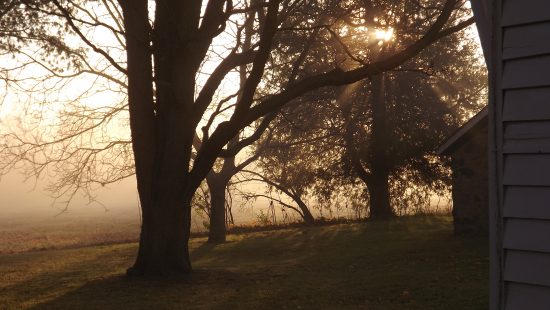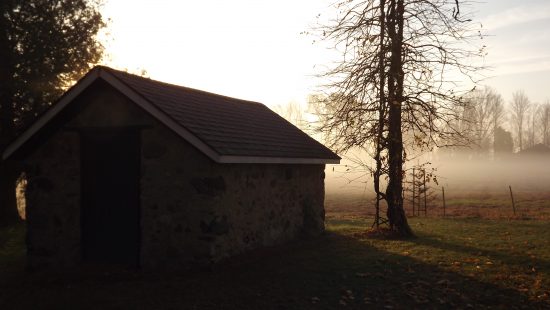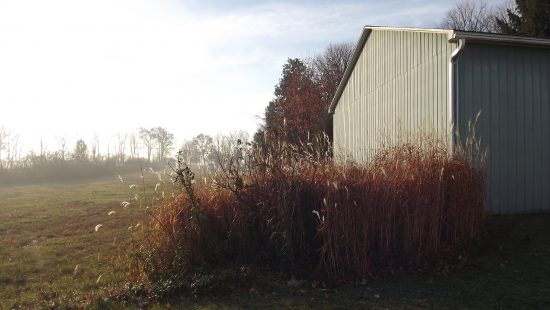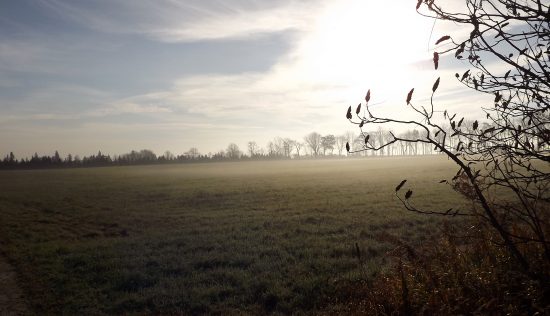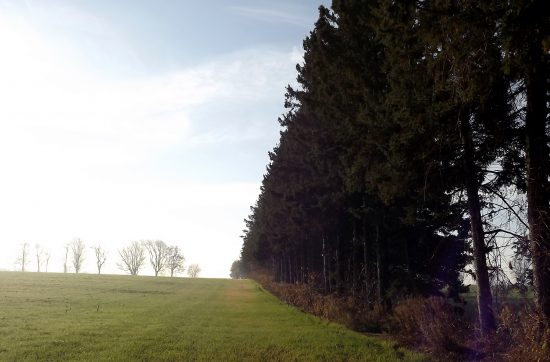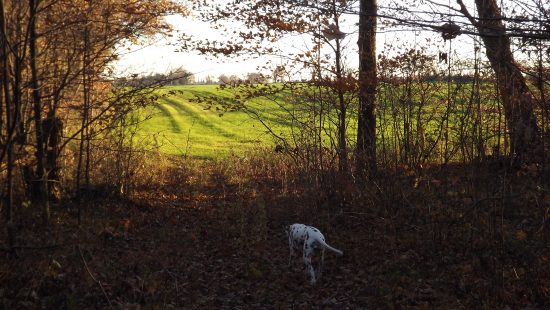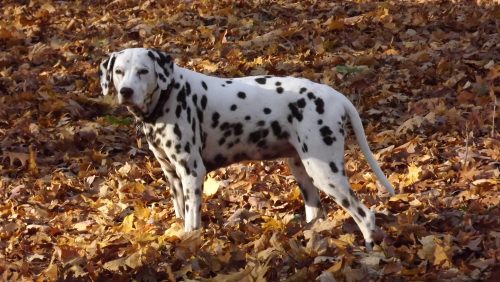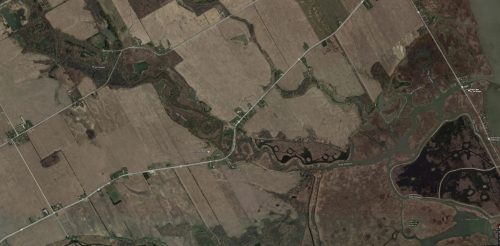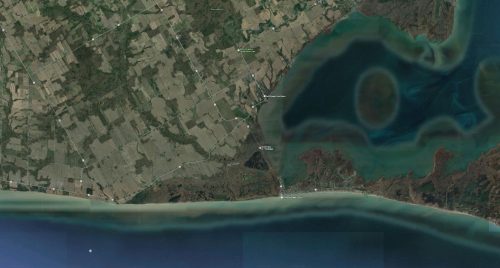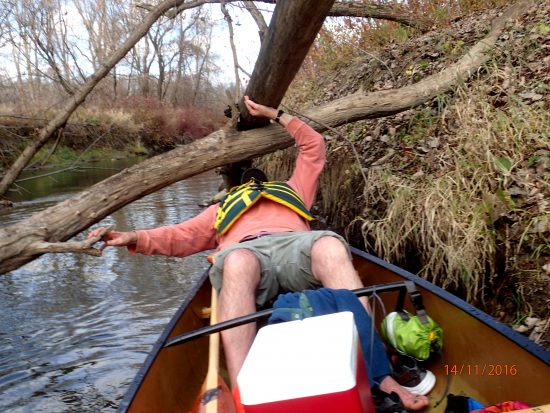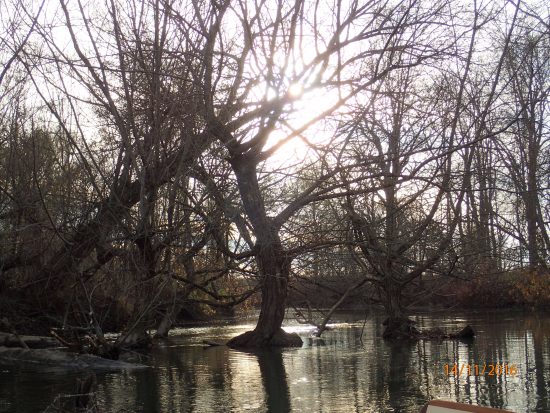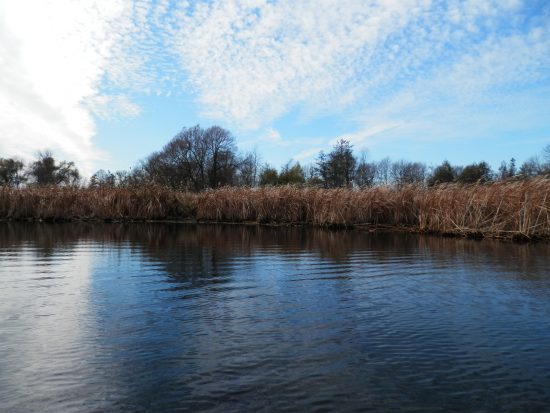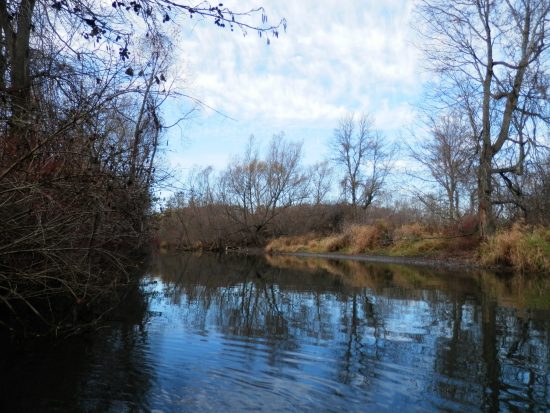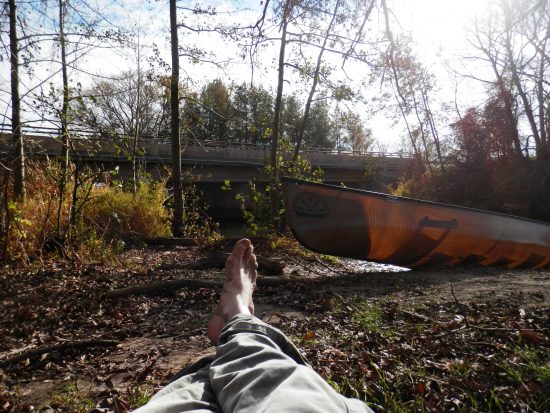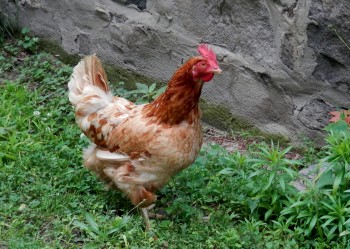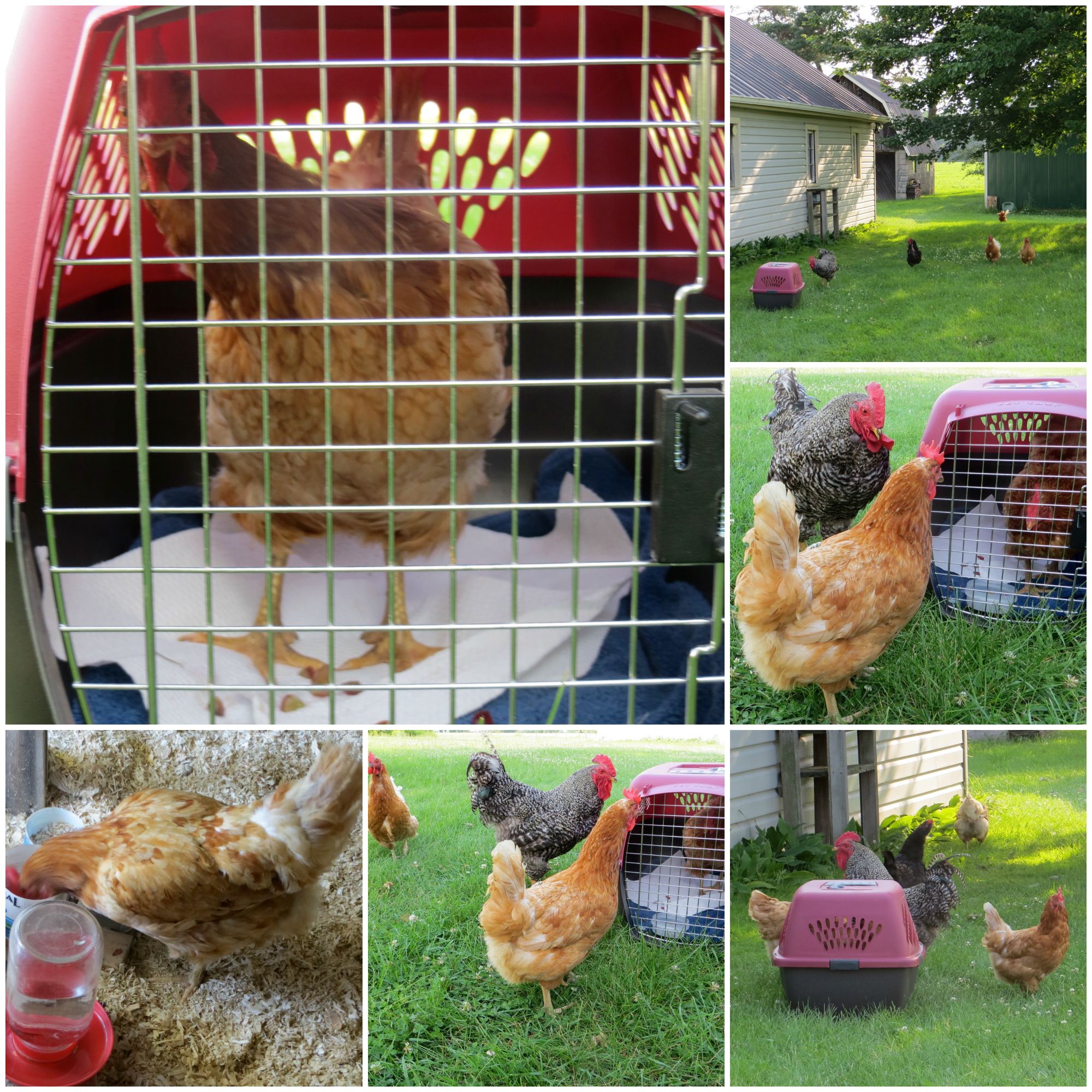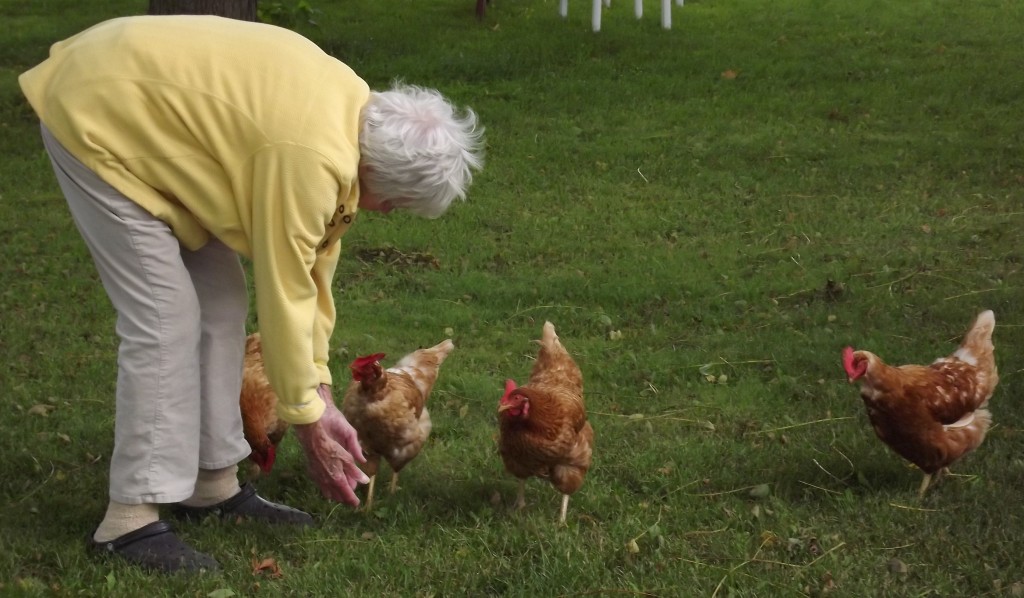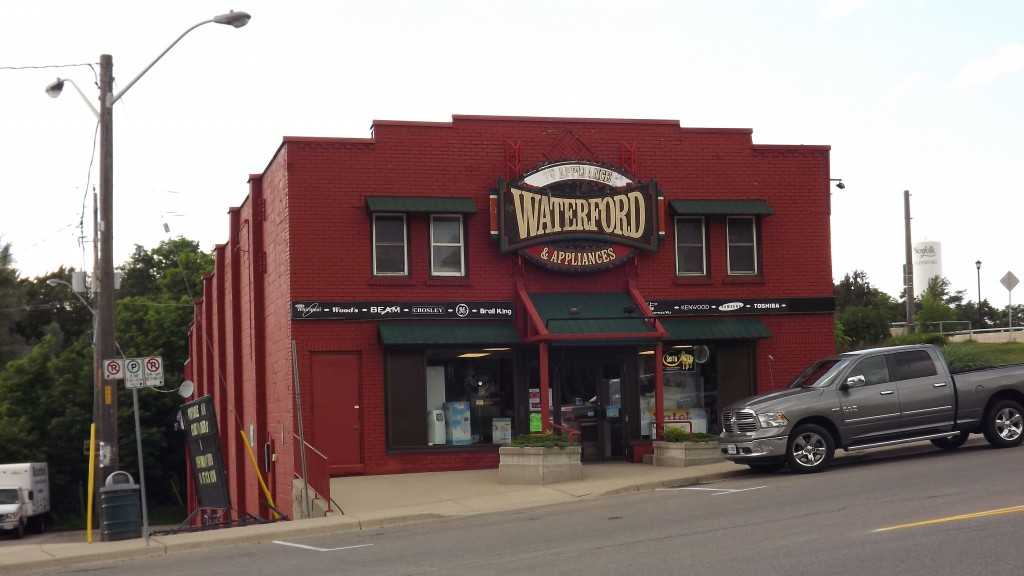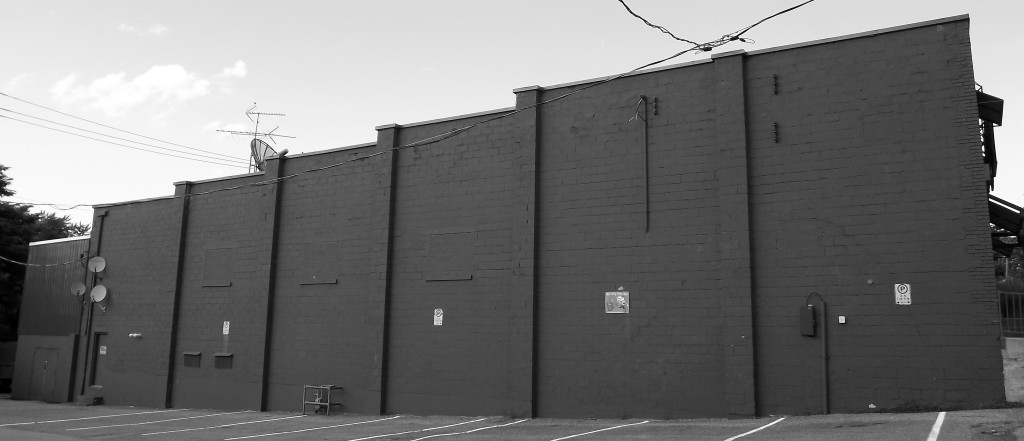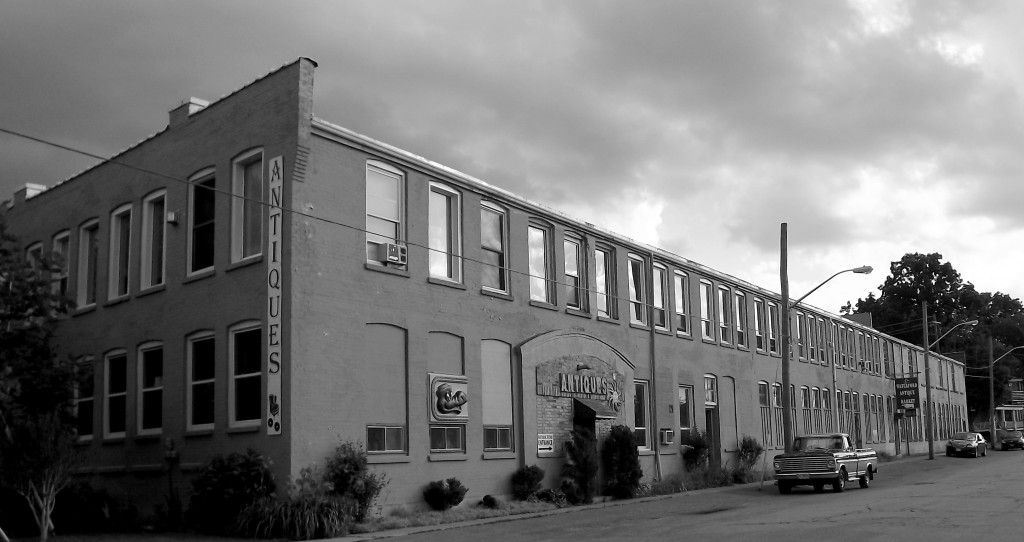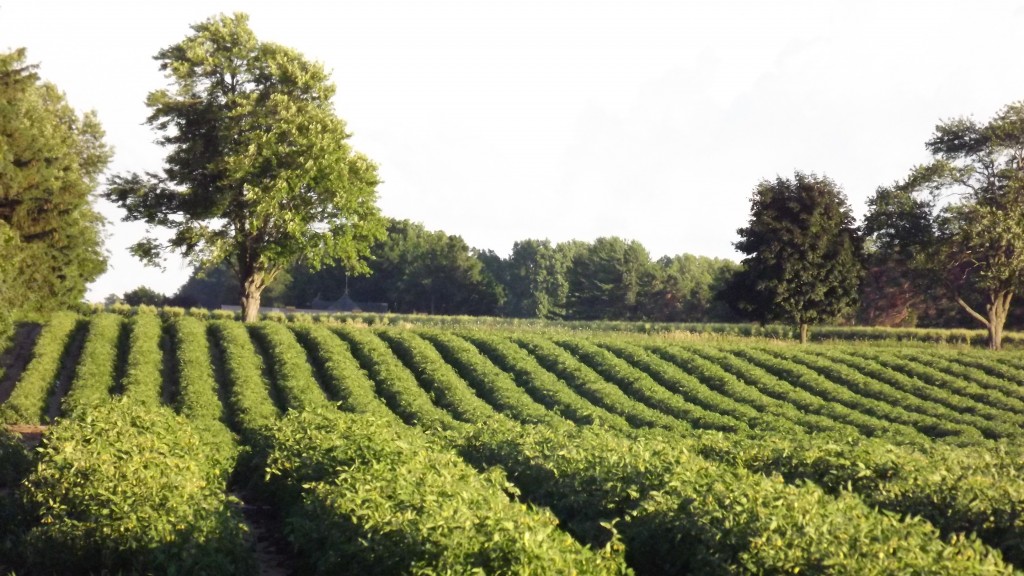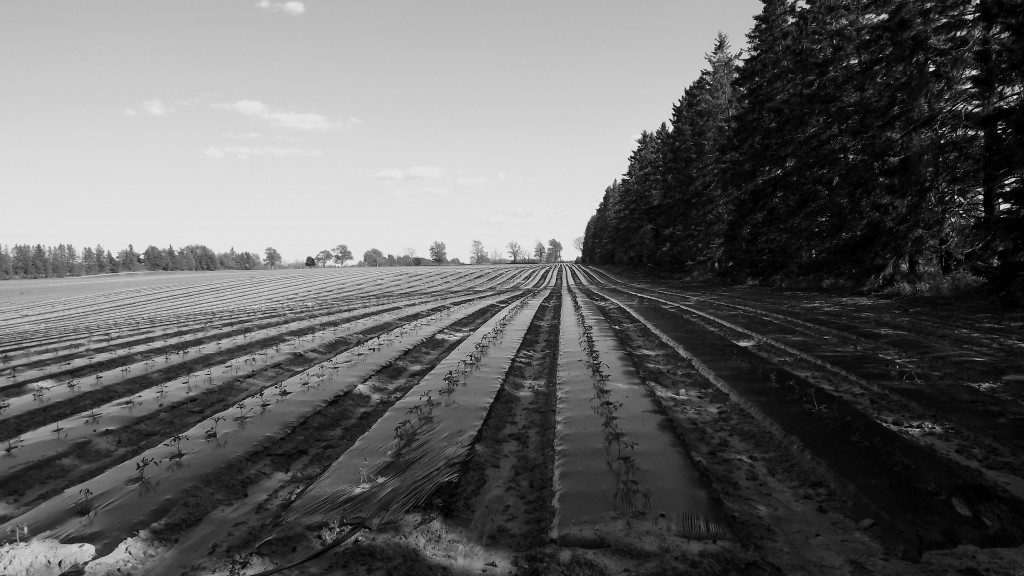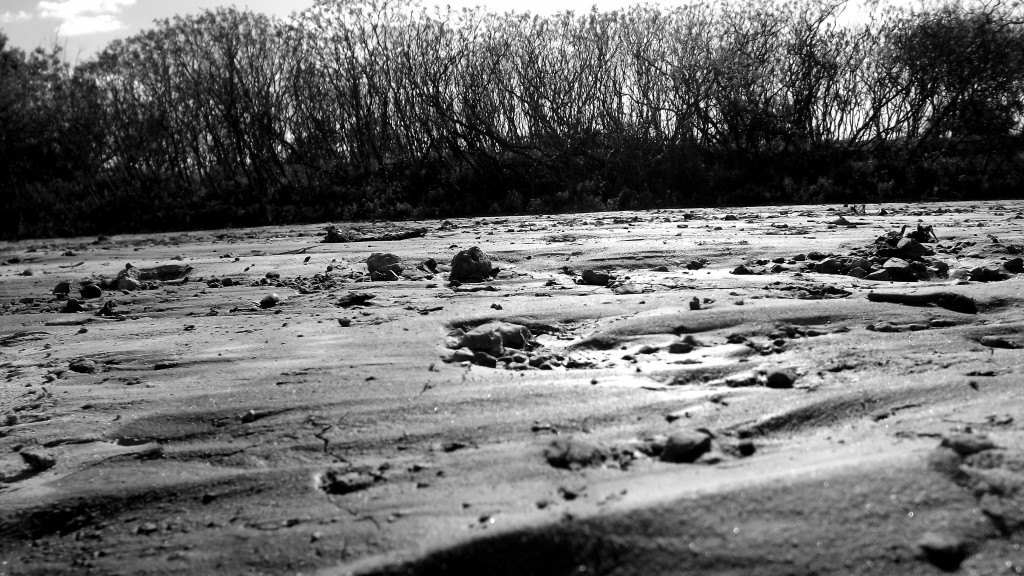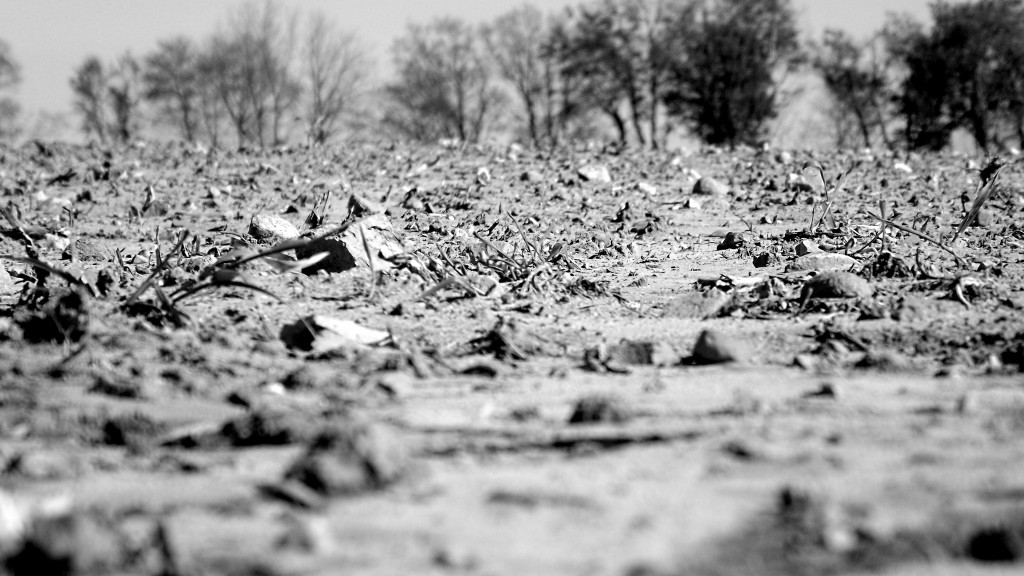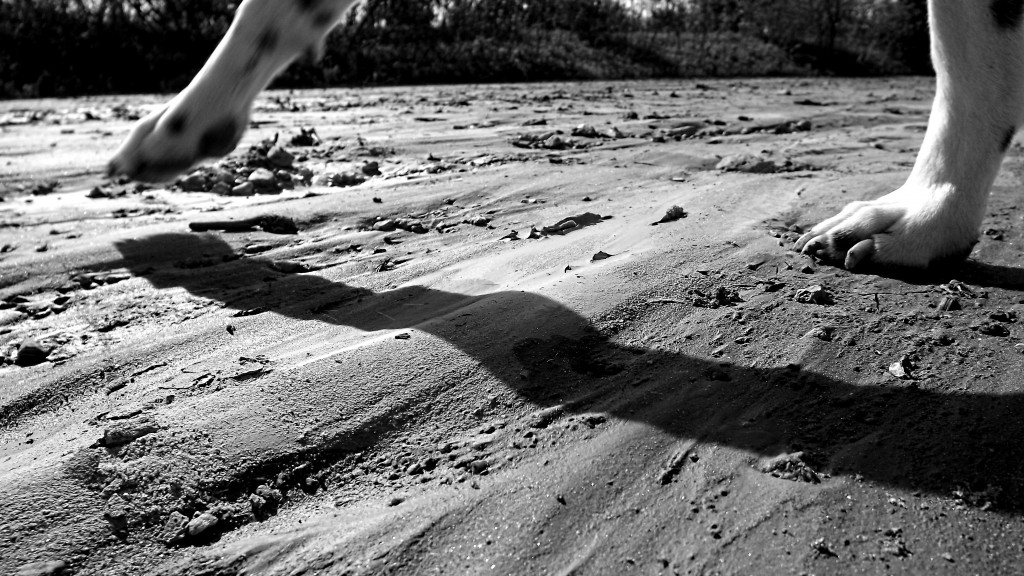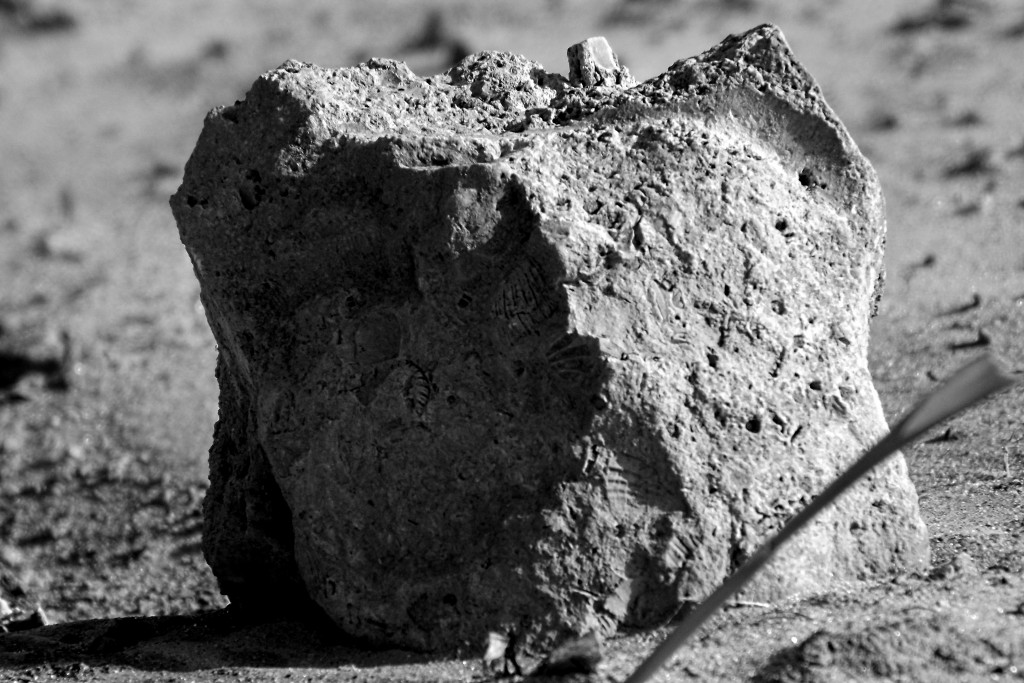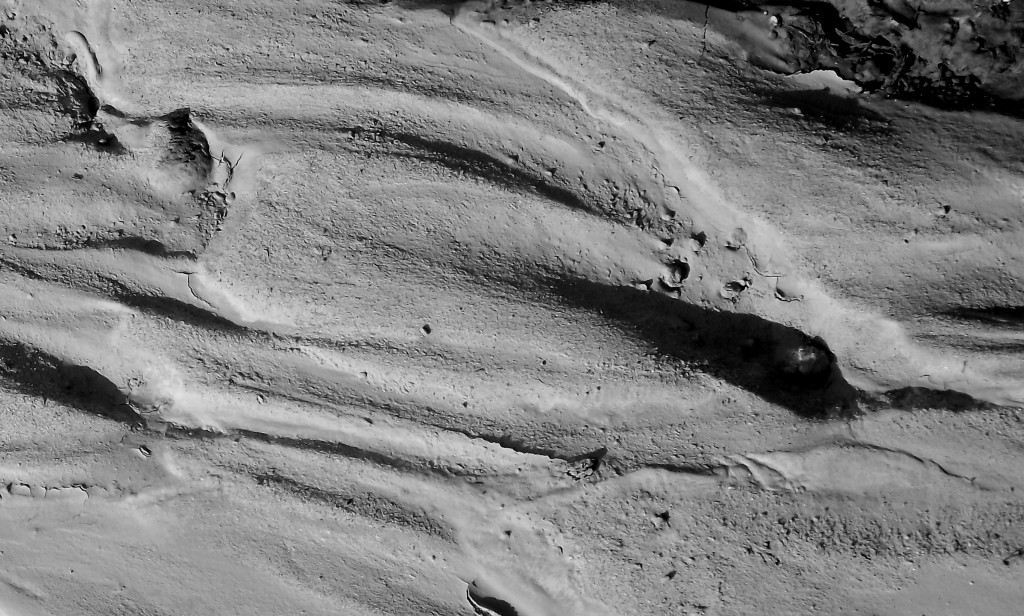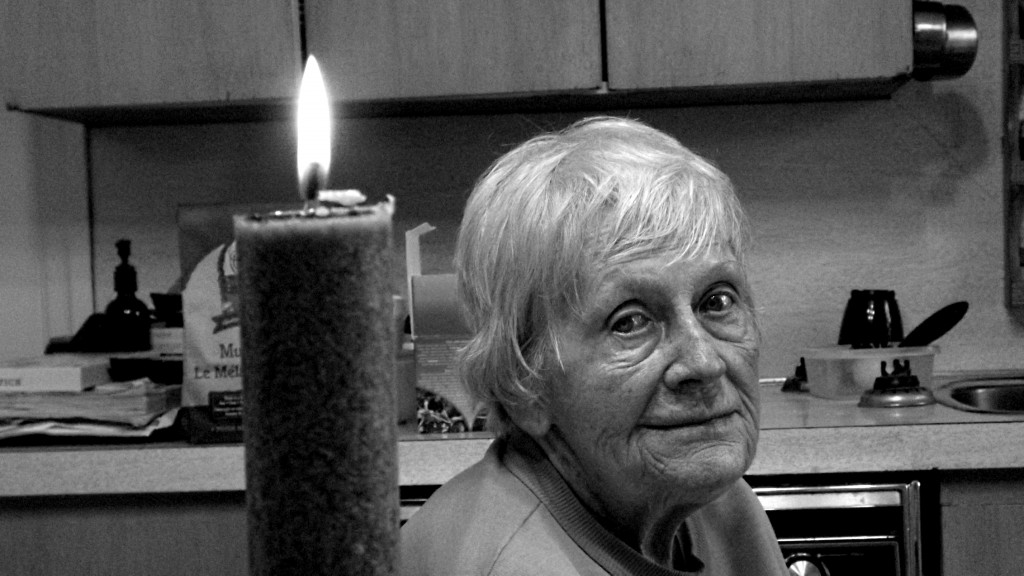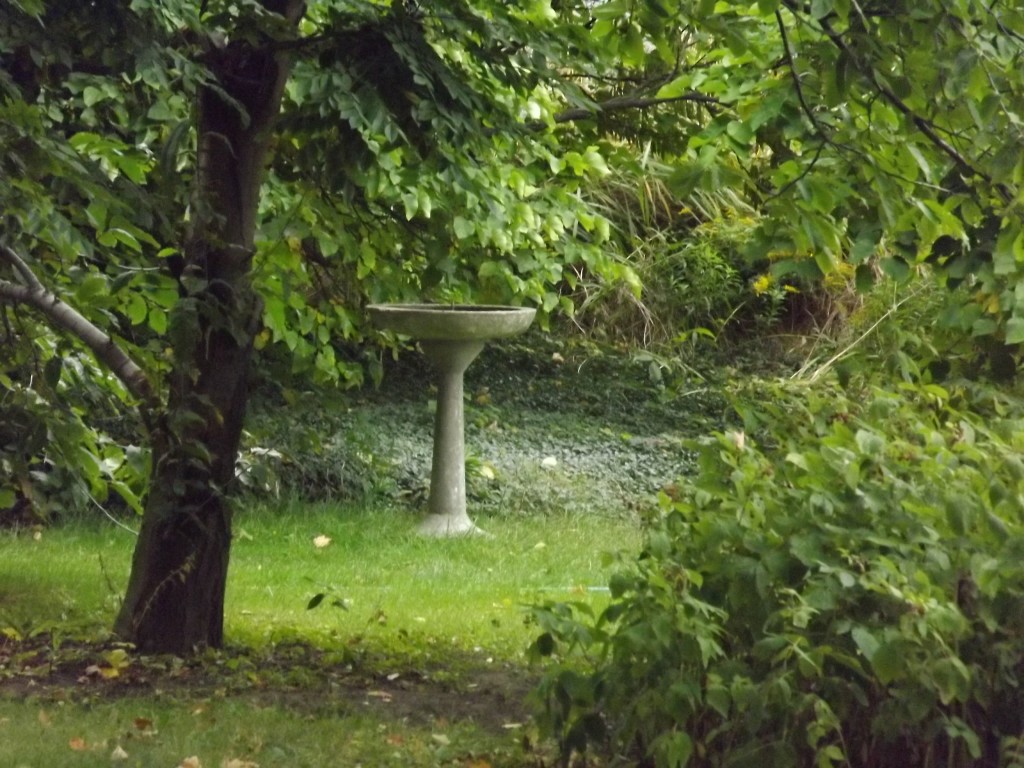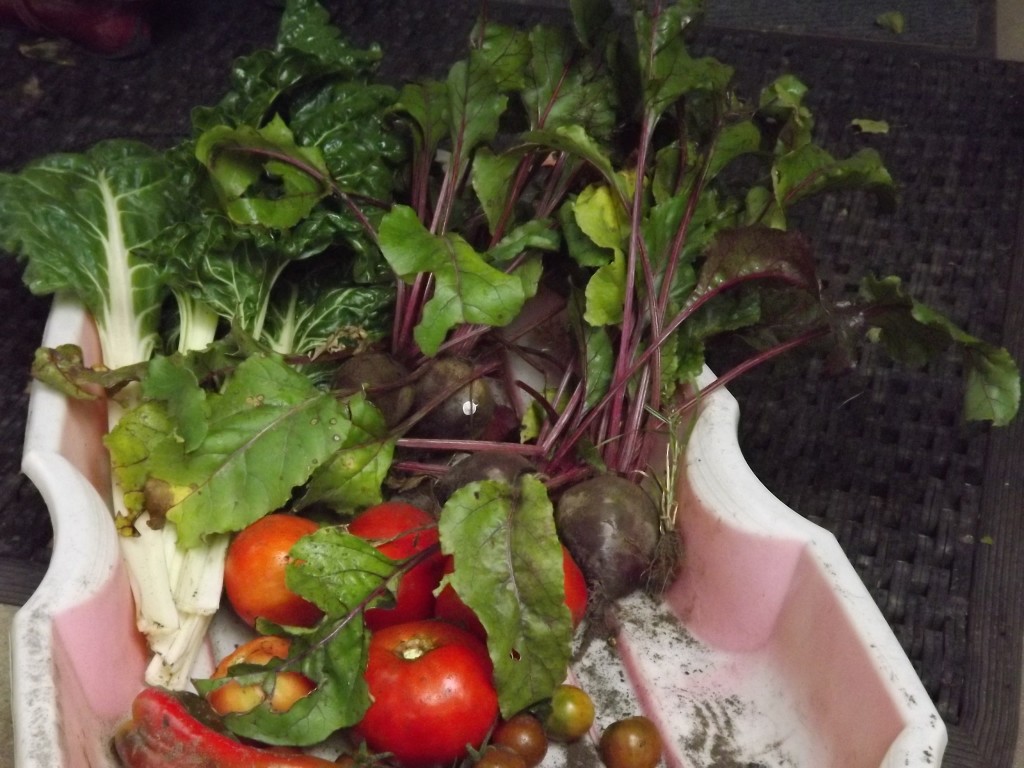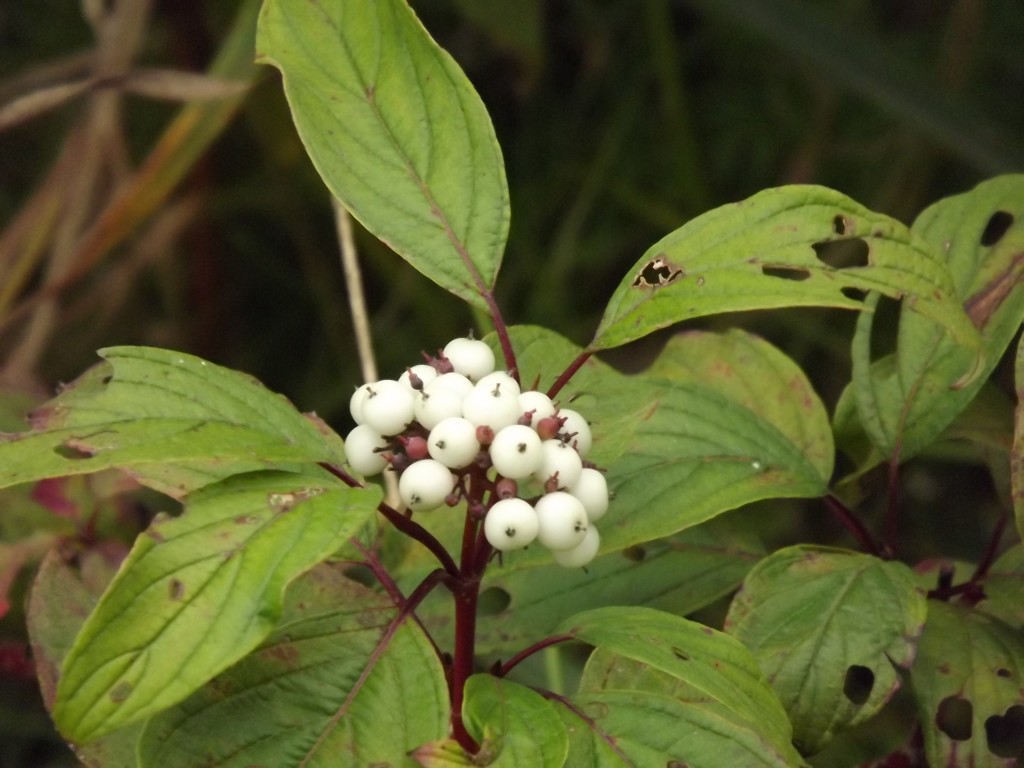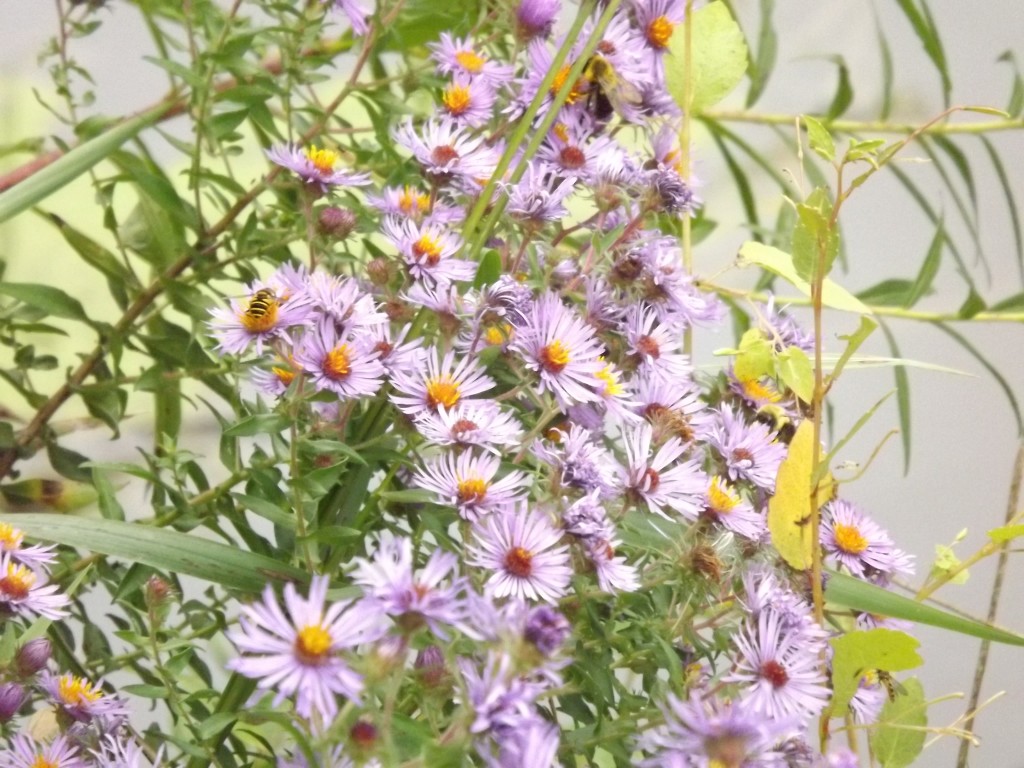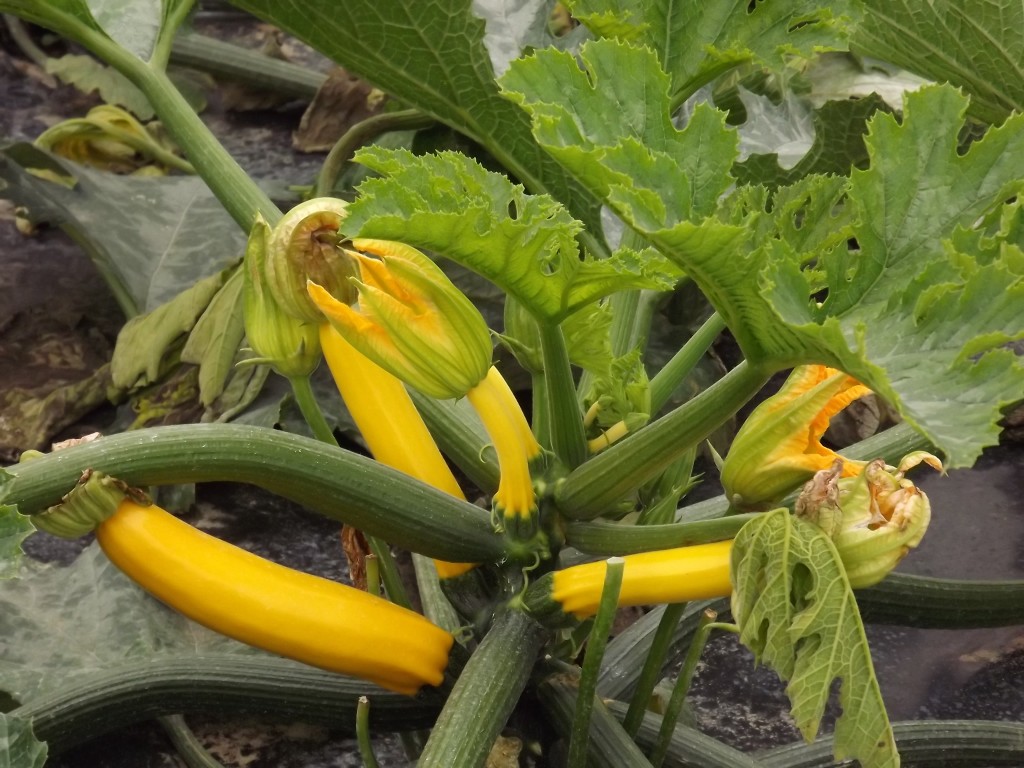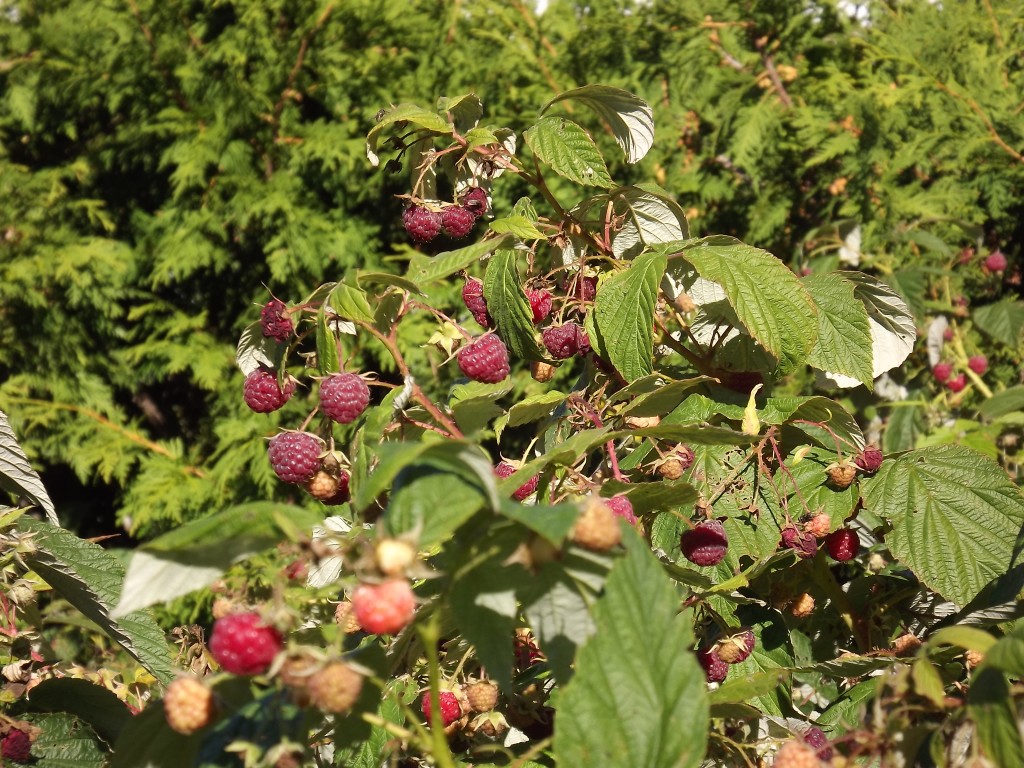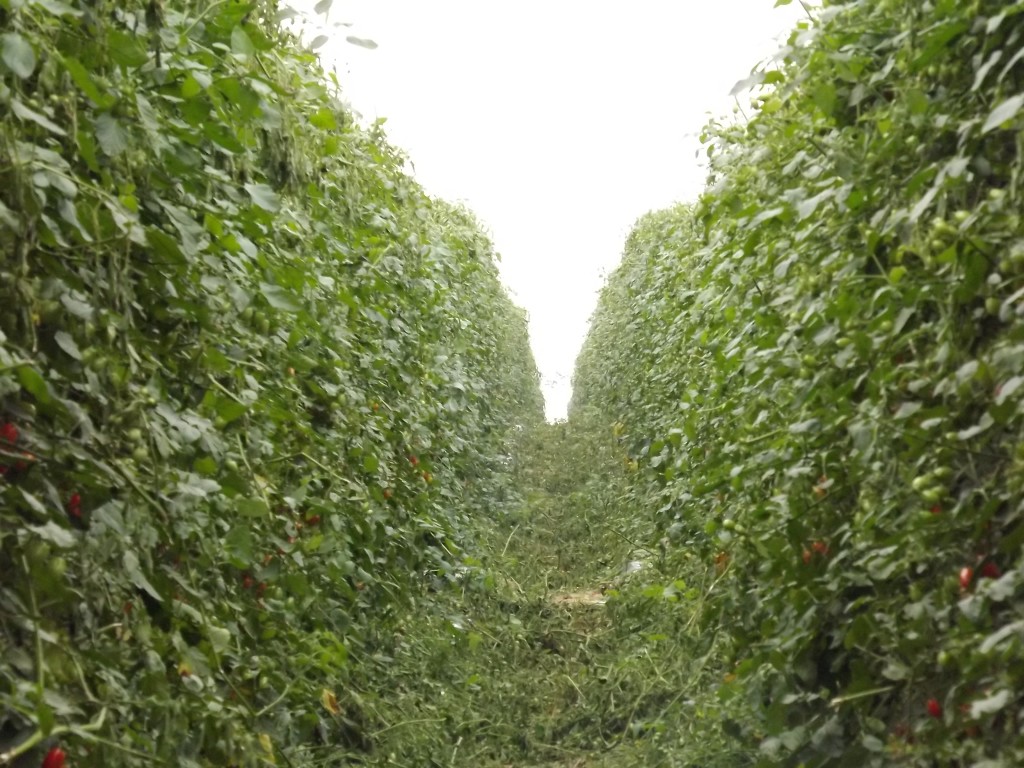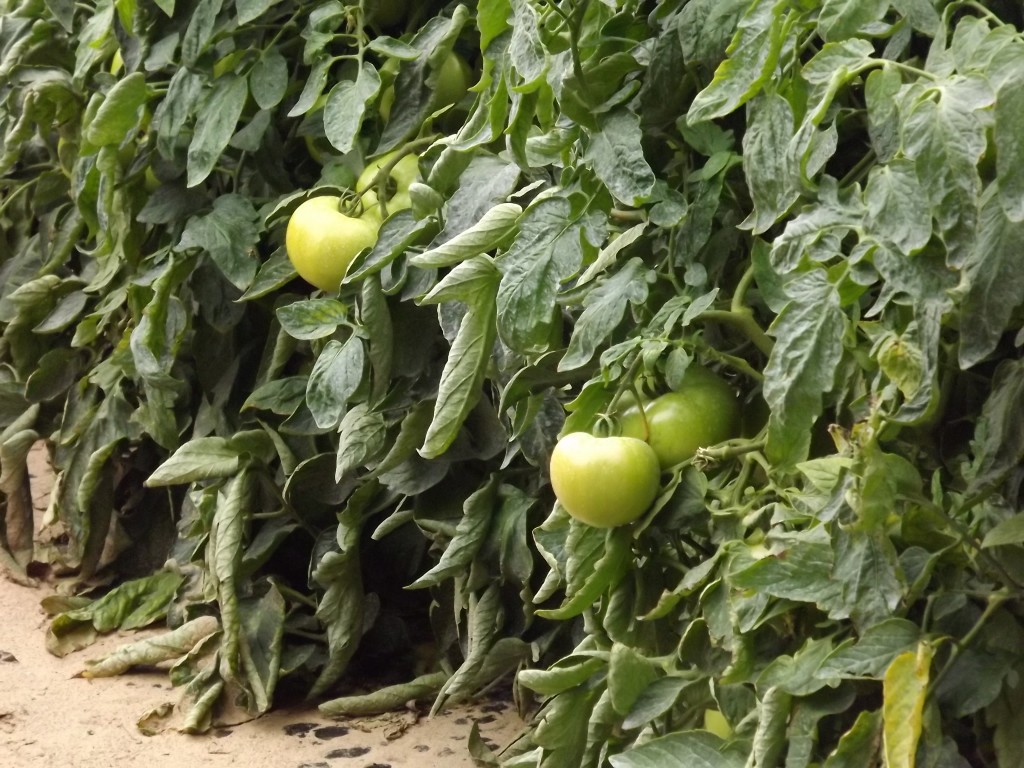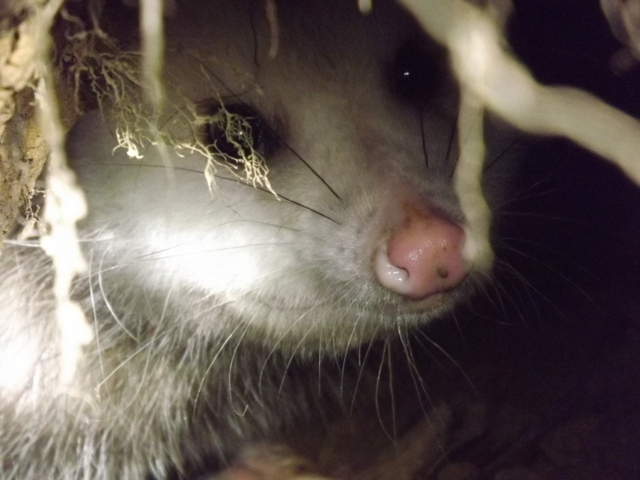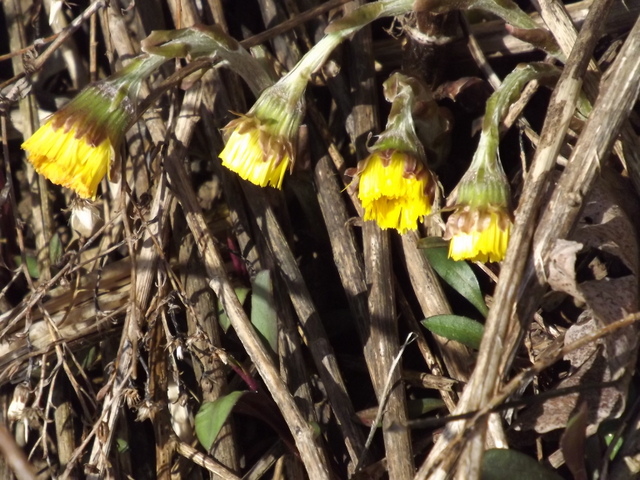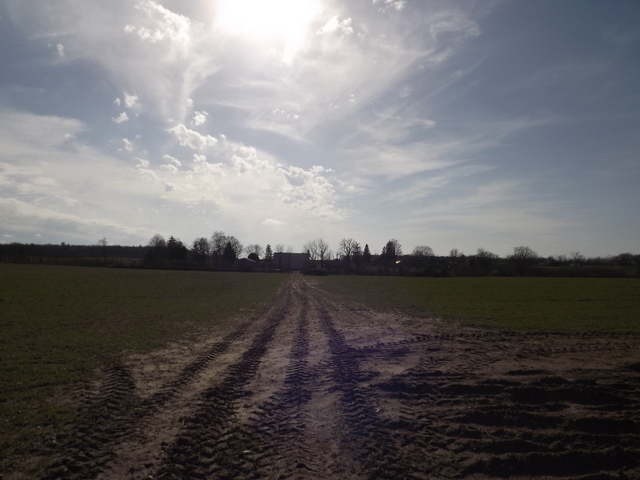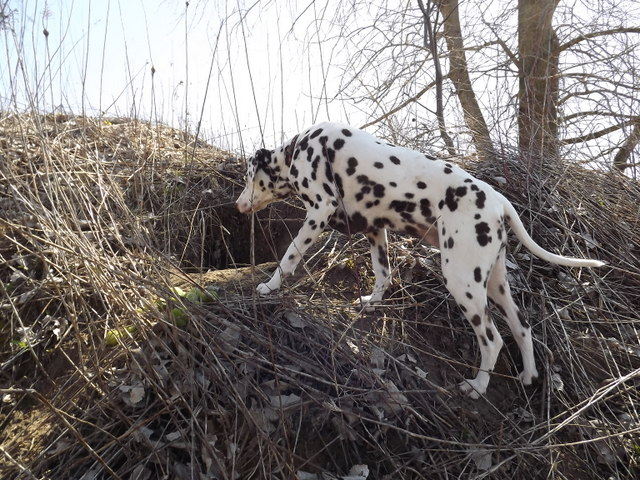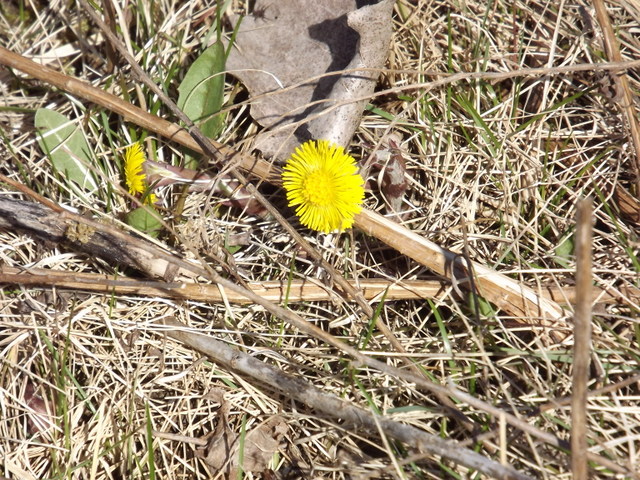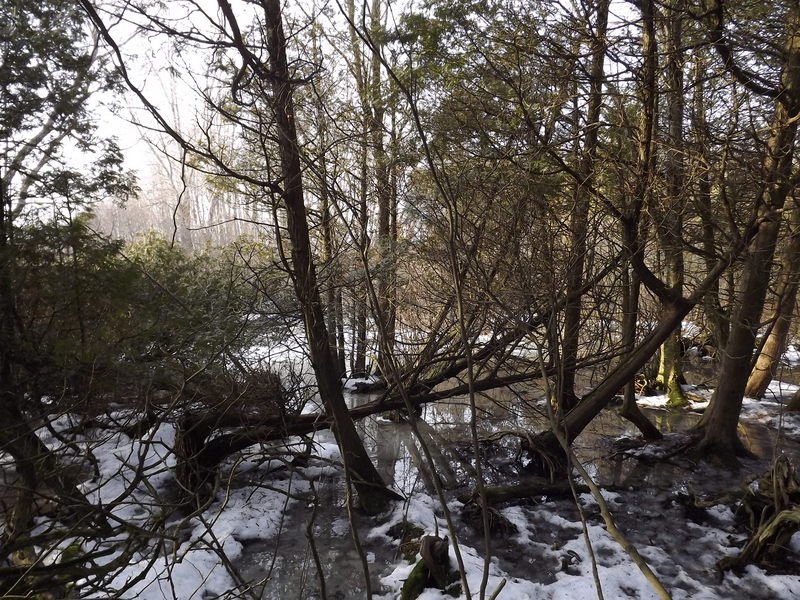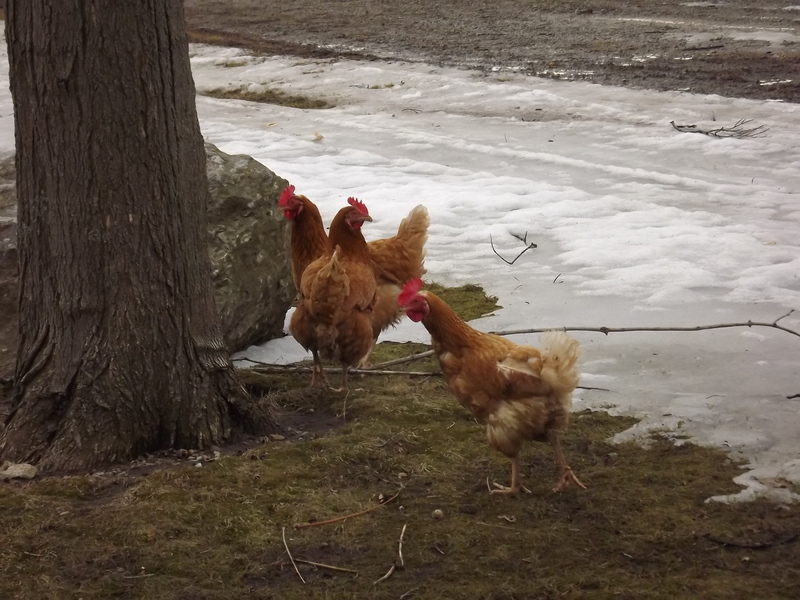I know that many of you envy the life of an internationally obscure writer, but I beg to remind you that sometimes there can be hazardous materials involved. Consequently, today I am modeling some DIY hazmat gear for the budget-minded author. Handy for wearing while reading reviews of your own work. This is not, as some of you might have waggishly opined, an erotic fetish costume, nor am I re-enacting a scene from an early Woody Allen movie. But I am on the farm in Ontario, and there is heroic work to be done. (I think I mentioned to some of you that I got the septic tank cleaned out two days ago — this has nothing to do with that!)
I also went to the grocery store, always a stirring experience, especially at sunset when the dear old Foodland parking lot is bathed in splendour.
Then I went to the woods to hunt for ramps. They are up, but we have so much ramp pesto from last year that it seems a shame to raid the beds again this year. And I forgot to take pictures of them. Anyone who wants to correct my identifications here can leave a comment.
 Daffodils Jean planted here and there in the woods
Daffodils Jean planted here and there in the woods
 Trout-lily or Dog-Toothed Violet or Adder’s Tongue
Trout-lily or Dog-Toothed Violet or Adder’s Tongue
Modern agriculture: You plant rye as a cover crop in the fall. It pops up in the spring. Then you spray a defoliant to kill the rye, disc up the land, and plant something new (the guys were out with the tractors today discing up this field). I took the picture a couple of days ago.
But then there is this.
—dg
DG and his intrepid close relative RG, who has appeared earlier on these pages, went for their usual pre-winter canoe trip on Big Creek (see Google map above: southern Ontario where Long Point juts into Lake Erie). RG fell in first unwisely trying to clear a snag. Then they went to another put in spot and realized they’d left the paddles back at the first put in. RG made DG stay with the canoe in the mud while he drove in his warm car (with heated seats) back for the paddles. DG, the creative mind behind NC, passed the time taking selfies. Then RG rammed DG into a thorn bush and his hand was bleeding. When they got back to the landing DG’s bare feet were so cold he fell over.
Actually, it was quite stunning (aside from the nature and brother-on-brother violence). Immense labyrinthine marshlands, many threatened species holding out there. Fascinating to me because in 1670, on Easter Sunday, two Sulpician priests, François Dollier de Casson and René de Brehant de Galinée, were struggling to cross Big Creek in flood when they heard above them the shrieks of horses, the jangling of harness, war cries and the sounds of battle. According to their journal, they knew exactly what it was, King Arthur’s Hunt. King Arthur’s Hunt is one name/a version of the legend of the Wild Hunt (also Charlemagne’s Hunt), which John Irving used in the short story “The Pension Grillparzer” in the The World According to Garp. Ghostly, wraithlike warriors riding and battling endlessly in the sky. Terrific to be in exactly that spot.
I have an anthology of quotations about Long Point and Norfolk County, including that journal entry, which you can read here.
dg
 DG intrepidly negotiating hazard.
DG intrepidly negotiating hazard.
—Photos by dg, rg & google maps
There is a tide and time in the lives of chickens, as there is in the lives of men and women. Many of you have watched the rise and fall of the hen population on the farm with amusement and sympathy. But things have gone south. In late spring, a Cooper’s Hawk took the third to last hen. Then the second to last fell sick and died (they were all getting old for chickens). And finally Jean broke her hip a few weeks ago (um, she’s 94), putting an end to plans for repopulation. Chickens are social animals and aren’t happy on their own. While Jean was AWOL in the hospital, I got in touch with Amber Homeniuk, poet (see her poems in the current issue) and Jean’s favourite chicken expert, who offered to rescue ours.
Here we have images and video of the last moments. Amber came prepared with a chicken carrier, also sliced grapes and chicken feed. And you can tell from the video what a gentle and reassuring animal wrangler she is.
Below the video is a collection of images Amber put together of the first moments at the other end of the exchange.
More about chickens than you ever wanted to know, right? But I’ll miss them. Surprising, sociable creatures. Nice to have around the place.
dg
Just back from a wild swing to the farm to oversee vast excavation and pipe-laying to repair the tenant house (twice burned down, but the original house was the first on the farm; ancient stone foundation dating to before 1850, we also found the remains of what must be the original well) plus swing to Toronto to see Jonah (hiked down the Humber River to the lake and back). Many pictures, no theme, my brain is a scattered mess.
Re. the pipe. We had a line locator come out to locate the old line, which he didn’t manage properly. So we had to follow the old pipe with the backhoe, a lovely serpentine hole with a couple of false tangents and trial digs here and there. Kind of interesting and delicate, especially at the very end when we were sure we were close to the main pipe. These digging photos are of purely documentary interest. No one made a map the last time the pipes were put in, and now I have pictures. Otherwise, I will spare you the details.
.
A
.
.
Images from the farm on Ontario, just these past few days. Lucy at the beginning, Jean at the end (93). In between, well, I got a bit obsessed with the clash of the industrial and the natural, which is modern agriculture. So I have three images of a Norway spruce windbreak, clouds spiraling up beyond them and a jet contrail. Then a series of images of tractor ruts in a rye field. I fell in love with the annual manure pile, never has a manure pile seemed so, well, epic. And finally we’re mounding the fields in preparation for planting. This is done with a machine, of course, that creates lovely symmetrical rectangular slices in the soil. The images are all variations. I like that, the repetition of the image with some slight variation.
The last time on the farm (Christmas) I had to dig out the risers to the septic tank to release the guard grid that had been improperly installed so that I could get at the plastic filter and clean it. This time a new experience: The tenant house has been without water since early March, frozen pipes we thought. I got the pipes to the garden hydrant turned on last week and then with the help and guidance of a neighbour ran a hose from the garden hydrant to the tenant house and attached it to the outside tap on the house wall, turned on the outside tap and ran water from the garden hydrant into the tenant house. I didn’t invent this, did not believe it would work, but it did. Low pressure but it works. Next we have to dig up the pipe to the house, which is clearly not frozen but blocked irretrievably.
I also spent a lot of time lying in the mud and ice on my stomach jamming a log up the irrigation pond overflow culvert, which has been partly blocked for a couple of years. This is a pilgrimage I make every trip to the farm. I have my own special log and I walk back to the pond, looking for arrowheads along a knoll where Early Woodland natives used to camp, and lie down with my face almost in the pond and run the log into the culvert. It is a zen thing to do and never works (also has a certain sub-erotic overtone, which I don’t really want to get into). Then Lucy goes for a swim, whimpering for me to throw a stick. This year there was still ice along the margins of the pond, but she still went in. We share this tendency to self-destructive obsession.
dg
.
.
.
 Bonnie Prince Charlie bidding farewell to Flora MacDonald on the Isle of Skye after the Battler of Culloden, from the London Illustrated News.
Bonnie Prince Charlie bidding farewell to Flora MacDonald on the Isle of Skye after the Battler of Culloden, from the London Illustrated News.
Okay, the referendum is today. A brief memoir: I have Scottish blood, McCall and McInnes. On the McCall side, there was a Scottish soldier who fought with Wolfe at Quebec and then came west along the Lake Erie shore during Pontiac’s Rebellion. He was demobilized in New Jersey, but left the United States after the Revolution and ended up in what became known as the Long Point Settlement in what is now southwestern Ontario. On the McInnes side, there was a fatherless boy, taken up by Sir Walter Scott, educated and sent on the Grand Tour, who then inherited slaves and a tapioca plantation in Curaçao. Later he became the youngest slave owner indemnified by the British government for giving up his slaves. He took the money, moved also to southwestern Ontario, and never worked again. The two families eventually intermarried and my great-great-grandfather Daniel McCall ran a store in St Williams, Ontario, on the Erie shore. At some point, someone in the family cut this illustration from the London Illustrated News, framed it, and hung it in the outhouse (posh outhouse). Later, my grandmother, who grew up with it, took the illustration to live with her. Now it lives with me, hangs above my desk. So now you know which way I’d vote. On the other hand, these things always have a way of disappointing romantics, so I can’t bear to watch the news today.
dg
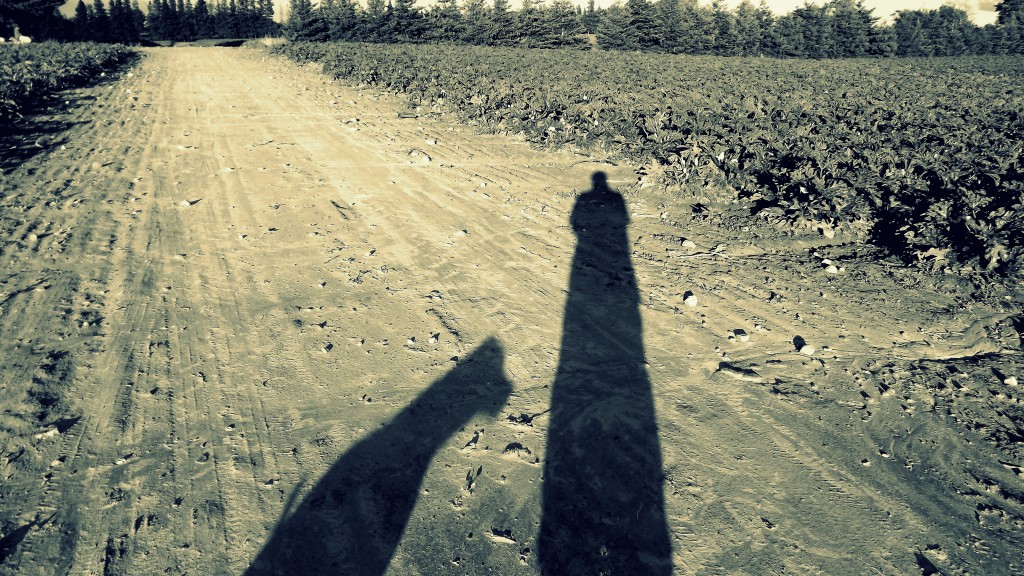 DG (right) and Lucy (left) on the farm (art shot — yes, I know it’s annoying).
DG (right) and Lucy (left) on the farm (art shot — yes, I know it’s annoying).
DG and Lucy were just on the farm in Ontario, you know, for a brief visit, a drug intervention with his mother, a fight with a young gun investment advisor trying to get his hands on his mother’s cash, a movie with Jonah (we went to see the latest Planet of the Apes extravaganza; very funny since he is moving to San Francisco in the fall and dg would keep saying, See, there’s your BART station and there’s your apartment without a roof), flea bombing the tenant house, and dinner with a dear old friend who had a heart attack a month ago and was put in an induced coma and quick frozen, apparently, with no ill effects. (The part about the drug intervention is a joke. Do I have to tell you everything?)
He found a treasure trove of old negatives and discovered that you can make pictures from old out-size negatives by using a laptop screen as a light box and taking a picture of the negative. Then he used photo software to invert the negative to a black and white photo. You should be impressed with his ingenuity.
So….
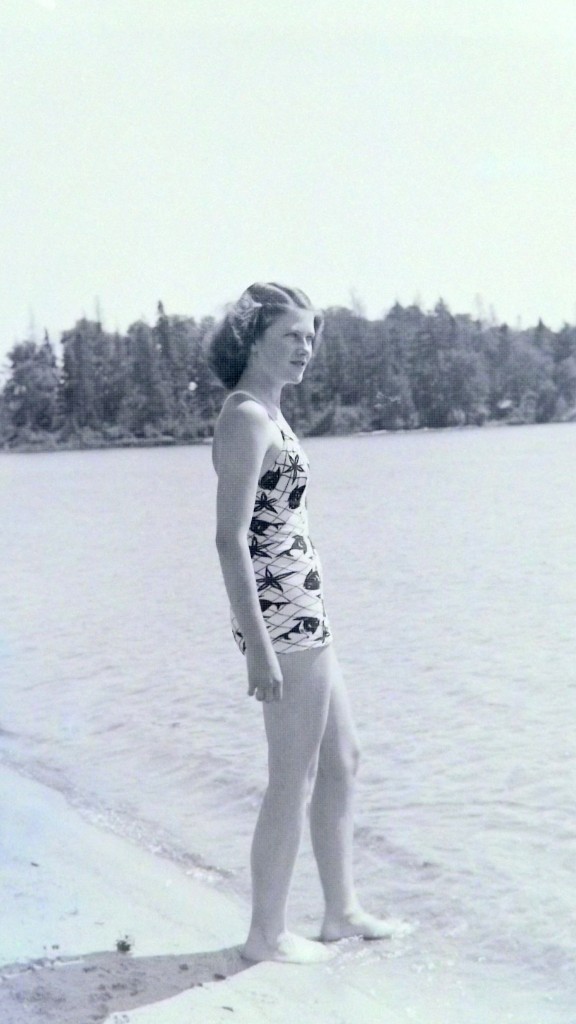 Jean somewhat earlier in life.
Jean somewhat earlier in life.
The nearest town is Waterford, where dg went to high school, about two miles from the farm.
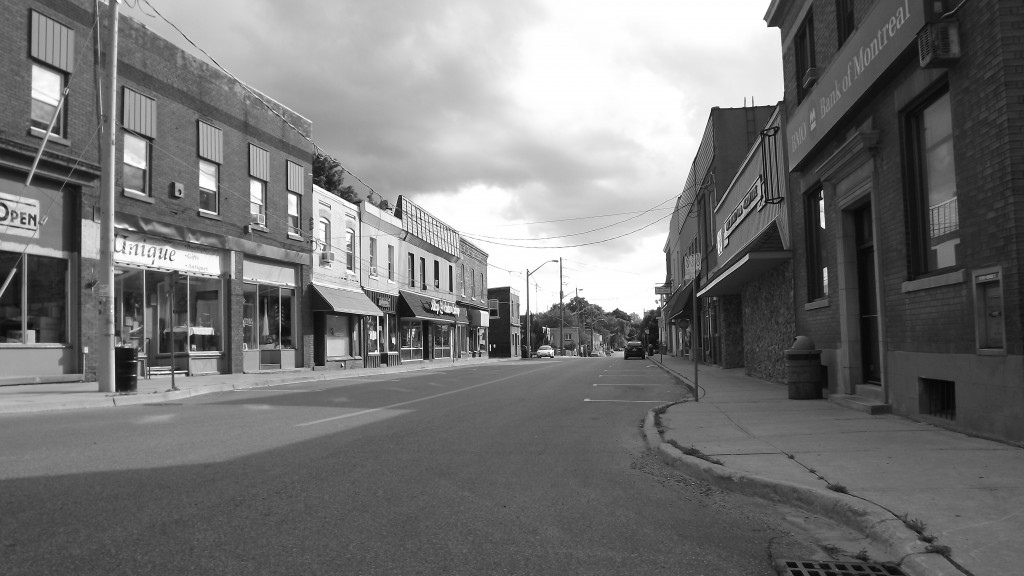 Alice Street, Waterford, rush hour. DG’s bank since childhood on your immediate right.
Alice Street, Waterford, rush hour. DG’s bank since childhood on your immediate right.
Here’s one of the town appliance stores. What’s interesting is that this used to be a movie theater. You can tell by the shape of the building. DG saw his first ever movie here, a documentary about Queen Elizabeth’s coronation. The fact that this was the first movie he ever saw and that it is burned into his memory tells you a lot about what is wrong with him.
After it was a movie theater, it was a pool hall, den of sin (according to Jean). Nothing but failed individuals and juvenile delinquents frequented pool halls. Then it was a lunch restaurant where farmers used to convene to drink coffee and talk about bad weather. DG can remember going there with his father and having hot turkey sandwiches with french fries and chocolate milkshakes. No better food has been invented since (he avers, nostalgically).
Another major landmark, sign of long gone industrial prosperity, is the old knitting mill (underwear factory), now given over to antiques.
Alice Street runs east-west. The movie theater was at the east end and the knitting mill was at the west end hard by the train station. The train from New York to Detroit used to run through Waterford parallel to Alice Street behind the bank and the theater. Now the former rail line is a hiking trail, and next to it is a rather peaceful series of ponds and lakes.
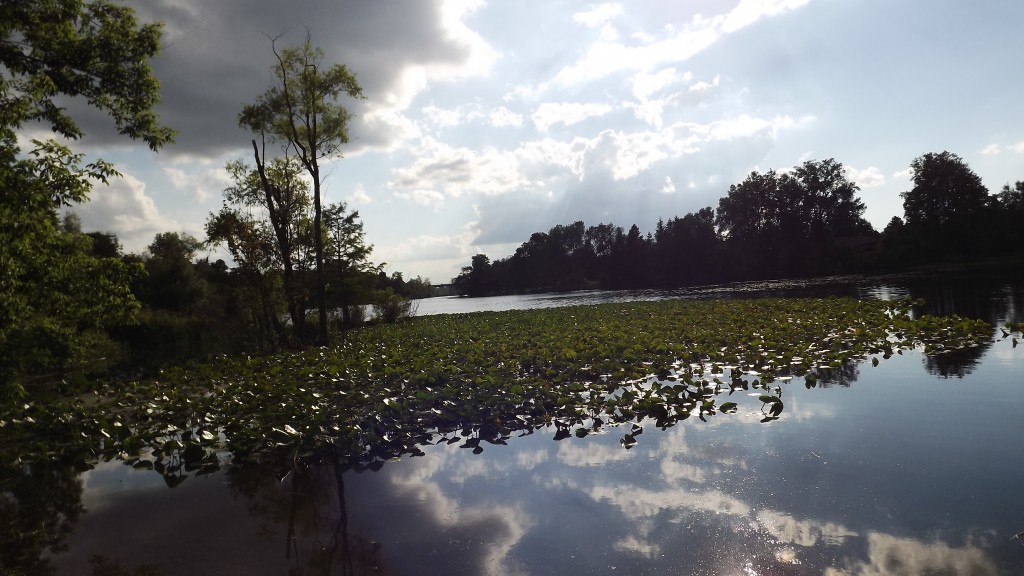 About 100 yards from the knitting mill.
About 100 yards from the knitting mill.
While dg was taking pictures he ran into a nice, depleted young man in a black leather pants, a Harley t-shirt and a black leather vest who opened up the conversation by saying he had a brain tumor but that his life had turned around recently when he began seeing UFOs. Apparently, crowds have gathered to watch the fiery lights go up and down the Grand River in Paris, Ontario, a nearby town. But even Waterford has had its visitations. (DG has always had a suspicion that he is not of this world. They are sending ships back for him.)
New word learned on this trip: earthing. It means to walk barefoot.
 Field of tomatoes on the farm.
Field of tomatoes on the farm.
 One of the chickens, looking a bit like an alien.
One of the chickens, looking a bit like an alien.
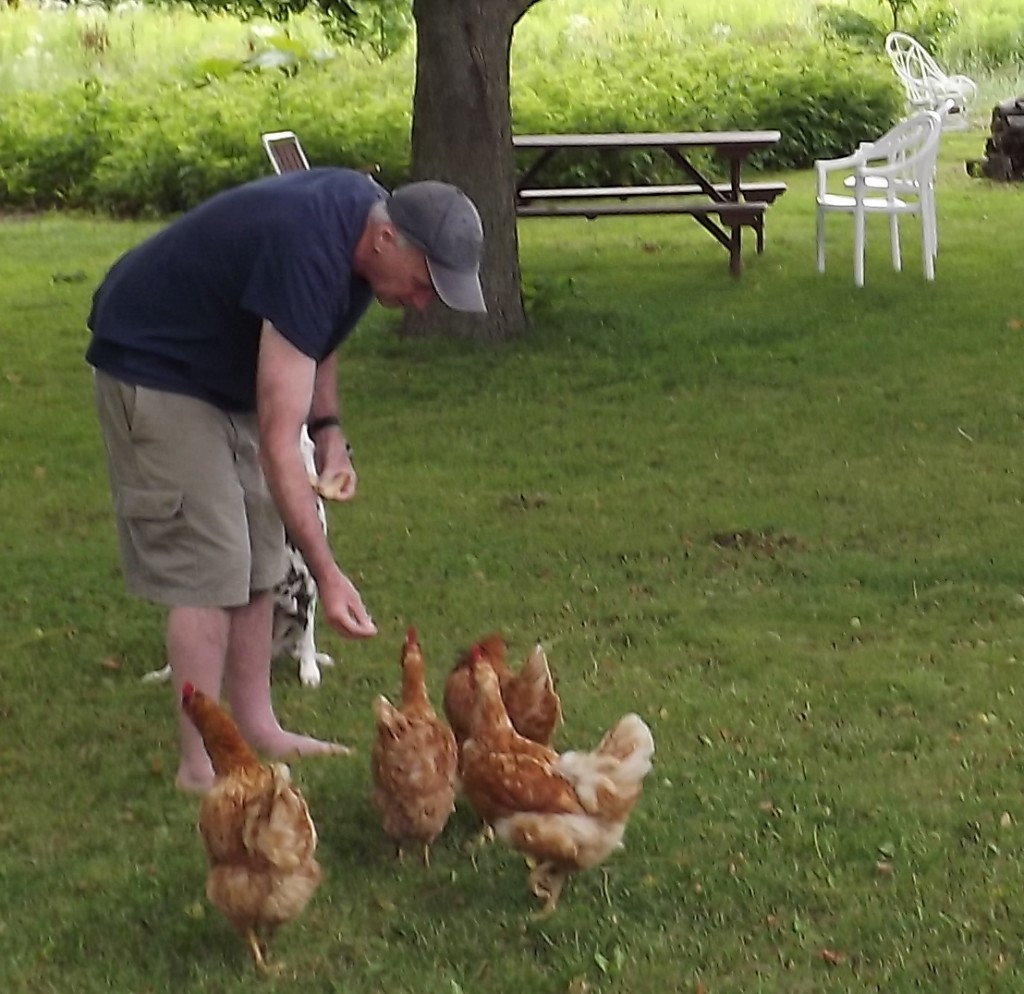 DG with the chickens (photo by Jean; this is her first photo credit, a milestone at 93).
DG with the chickens (photo by Jean; this is her first photo credit, a milestone at 93).
—dg
Moonlight illuminates the dancers
and the whitewashed concrete birdbath by the standpipe
and coiled green garden hose and the liquid amber gum tree
and the tree nursery under the chicken-wire frame
that keeps out rabbits and deer.
— from “Dancers at the Dawn” in Savage Love
Here is a picture of the birdbath that appears in Savage Love. You can’t see the standpipe, and the tree nursery is gone, but the liquid amber gum is behind the birdbath. I’ve probably said this before: the farm is in southern Ontario, about 20 miles north of Lake Erie just outside a little town called Waterford.
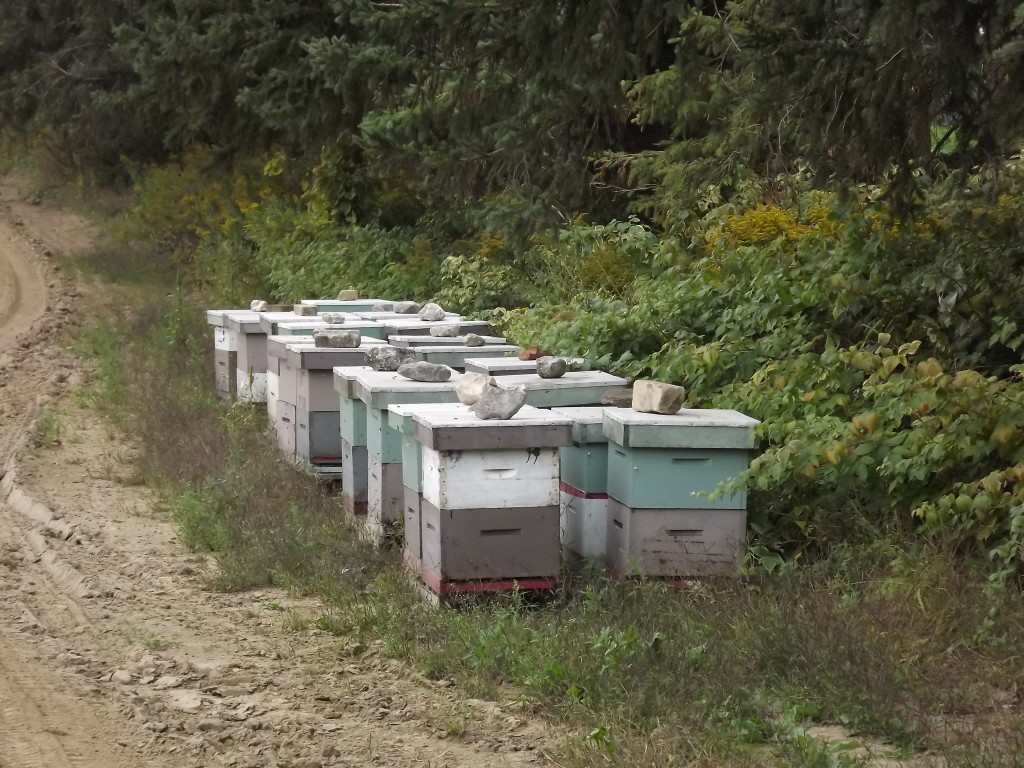 Hives are brought onto the farm during the growing season.
Hives are brought onto the farm during the growing season.
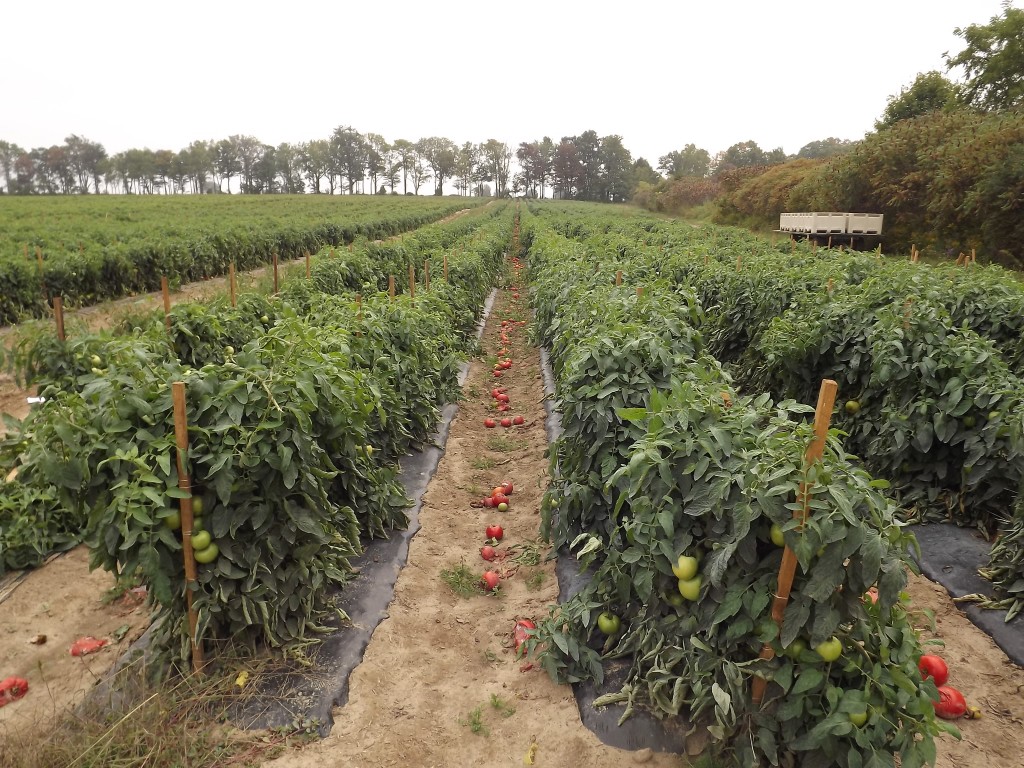 Field tomatoes, note the wastage, a fact of modern agriculture — many of these are perfectly good tomatoes that can’t be sold in the current market.
Field tomatoes, note the wastage, a fact of modern agriculture — many of these are perfectly good tomatoes that can’t be sold in the current market.
—dg
One of those recent trips took me to Canada, where I was one of six artists participating in a couple of mixed-genre events. These were arranged by the wonderful Ontario poet and essayist John B. Lee, whose works are so copious, accomplished and varied that I can’t single out any one, two or three books by his hand to recommend. Google this terrific author and you won’t be disappointed, whichever book may catch your fancy.
Besides John, I sat in with Marty Gervais, another more than noteworthy Canadian poet (and journalist), one whose modesty, both personal and literary, belies a huge soul and deep insight; and with longtime friend Douglas Glover, whose readings of some of his short-shorts (though he practices a number of other fictional and essayistic modes) roused the packed houses, first, in Port Dover, a wonderful and funky Lake Erie fishing town, and then, two hours to the west, in Highgate, where we performed in a beautiful old Methodist church, reclaimed as an arts center.
I must likewise mention the two musician-songwriters who rounded out the bill. Young Michael Schotte is, simply, a guitar virtuoso; check him out too. And our master of ceremonies, Ian Bell, curator of the excellent Port Dover Maritime Museum, is also a fine instrumentalist. Ian is also author of song lyrics that are every bit as “poetic” as anything else I heard on those stages. Look him up– and prepare to be mightily impressed.
via Sydney Lea’s Blog: Don McKay and Canada’s cultural riches.
Back from epic, marathon reading and interview trip to Ontario. Arrived in an ice storm. Gorgeous reading events hosted by Ian Bell (his father was my Grade 11 history teacher) and John B. Lee (multiple publications on NC). NC Contributing Editor Sydney Lea was there and I managed to get a photo of him looking like God at the reading in Highgate. Also my very first book publisher, Marty Gervais. The mix of music (Ian Bell and the amazing Michael Schatte) and literary reading was surprisingly entertaining. People paid money to come. Doing two events back to back with a long car ride in between (with stops to visit memorials for famous forgotten Canadian poets and to cast an eye on John B. Lee’s ancestral farm) made me feel like I was on tour with a troupe of actors.
Sunday, I had brunch with the Jernigans, Kim who used to edit The New Quarterly, and Amanda, the poet, and her husband, the photographer John Haney (both Amanda and John have appeared on NC). This was all the more remarkable since they had not had electricity since Thursday (the ice storm). Then I drove to Waterloo to see Jonah and also Dwight and Kathy Storring (Dwight published a play on NC; their son Nathan has an essay here).
Do you get the impression that there are secret NC cells planted all over (you know, mostly so I can travel without paying for food)?
The photo below was taken by Zach Melnick during the War of 1812 documentary interview he did with me on Thursday in the farmhouse living room.
dg
DG being interviewed at the farm, photo by Zach Melnick
Sydney Lea reading in Highgate, Saturday evening
Michael Schatte compilation, on tour with us he performed solo
Possum I found in a den by the pond at the back of the farm
You can hear the dog whimpering next to me. Notice the feet. I once raised a young opossum, called Snuffy, at first I kept him in a fleece-lined leather glove (approximating a mother’s pouch, I thought). My friend Bruce Hiscock did a drawing which hangs in the house. When he seemed big enough, we let Snuffy go in the woods. My great-grandfather was an amateur poet who called himself “Possum” and kept a stuffed opossum in his store. I published an essay about him in The New Quarterly a couple of years ago. More information than you need, right?
First flowers, Coltsfoot
My father once planted a small field with Scotch pine to sell as Christmas trees. As he once observed, they kind of got away from him.
Daffodils in the woods. There are patches all through the woods, planted by DG’s mother.
The farm buildings from the east.
Dog
Dog investigating possum den
Coltsfoot
Geese by the pond
Laneway. To the right, a spruce windbreak. To the left, a field of oak and white pine planted over 15 years ago for eventual harvest.
Ground still frozen, huge trucks ferrying in loads of fertilizer. The tractor is just there for colour and to make nice circles in the snow. Old farming joke: Contrary to popular belief, plants don’t get nutrients from the soil. The soil is just to hold the plant down and then you pour fertilizer on it. These fields will be planted with canteloupes.
The next day it thaws. A pile of irrigation pipes sinking into a field of melt water.
The swamp at the back of the farm is the headwaters of a creek that eventually flows into Lake Erie, twenty miles away. This is precisely where the creek begins.
Cedar trees in a copse dg’s father used to call Hernando’s Hideaway (his reasons remain obscure but mysteriously romantic).
Wild turkey tracks, not to be confused with chickens (see below).
Chickens. Reminded DG of Culebra.
Sick chicken sleeping by the dishwasher in the farm kitchen. (The chicken’s name is Annette.) The chicken has moved into the house. It is like the pioneer days when people and farm animals lived together.
Chickens haunt dg’s dreams.
—dg
Drove to the farm in Ontario with younger son and dog yesterday, in time for an evening walk around the place. Fields of melons, tomatoes and corn. A coyote den. I don’t know if you can tell from the pictures but everything is very dry, soil like white powder, the unirrigated crops looking decimated with patches of withered or non-existent plants. Even the weeds are drying up. We have irrigation so the issue is not so pressing.
dg
Here’s Jean Glover, dg’s mother, reciting Sir Walter Scott’s poem “Breathes there the man with soul so dead…,” actually an excerpt from “The Lay of the Last Minstrel.” This is unrehearsed and you can hear the refrigerator whirring in the background as well as assorted whining dogs who, apparently, cannot abide the poem (everybody’s a critic). We were sitting in her kitchen, on the family farm in Ontario. She rides a stationary bike most days over the winter and memorizes poems while she’s riding. Scott is a favourite because her great-grandfather (or is it great-great…?) was raised by Scott who, seeing the boy playing in the street one day, discovered his widowed mother and offered to pay for the boy’s education. The family story is that Scott was writing his novel Rob Roy at the time. The boy and his brother were in and out of the Scott house as they grew and later Scott paid for them to go on the Grand Tour (somewhere there is a diary of this). The boy eventually succeeded to some family money and owned slaves and a plantation on the island of Cariacou. As soon as the British government offered to buy the slaves and free them, he sold up and moved to Canada. His daughter Anne married Daniel Abiel McCall. And their daughter Sarah married John Brock. And their daughter Kathleen was Jean’s mother. I give you the stripped down version of the story—we are a family that carries some history in its genes. And thus Scott comes easily to her mind. There is some Scott silver somewhere in the house, passed down through the family. In the video, Jean is just shy of her 90th birthday.
dg
.
.
Here’s the poem:
Breathes there the man with soul so dead
Who never to himself hath said,
This is my own, my native land!
Whose heart hath ne’er within him burned,
As home his footsteps he hath turned
From wandering on a foreign strand!
If such there breathe, go, mark him well;
For him no minstrel raptures swell;
High though his titles, proud his name,
Boundless his wealth as wish can claim
Despite those titles, power, and pelf,
The wretch, concentred all in self,
Living, shall forfeit fair renown,
And, doubly dying, shall go down
To the vile dust from whence he sprung,
Unwept, unhonored , and unsung.
—Sir Walter Scott
 The first poem I can recall, aside from nursery rhymes, was a rondeau written by a Canadian artillery officer (and medical doctor), John McCrae, in 1915. It’s also the first poem I ever memorized. I can still remember the words written on the blackboard. This was a different world. We still sang God Save the Queen before classes started and recited the Lord’s Prayer, and there was always a Union Jack and a picture of the Queen prominently displayed. And every November there would be men or women in blue blazers and berets at the bank door in Waterford with trays of poppies. I remember being very proud of myself for memorizing the poem. And on Remembrance Day, we were all (brothers & parents) going to town for the ceremony at the cenotaph. We stopped to pick up an elderly neighbour who lived alone in a little house at the edge of our farm. He was a retired teacher and classicist, living quietly with his books. I was sitting in the backseat with my father and brothers and cheerfully began to rattle off the poem in a boyish singsong. My father gave my arm a squeeze and shushed me and whispered: “Not now. His son died in the war.” I shut up, confused, suddenly aware, acutely aware, that literature isn’t just words on a page but somehow rooted in our personal lives, in our deepest feelings about love, loss and death. I think it hadn’t occurred to me before that people actually died in the war. I didn’t, of course, know the poem was a rondeau, but the form itself has sunk deep into my brain. McCrae was born in Guelph, Ontario, a university town about 50 miles from where I grew up. He had fought with the Canadian artillery in the Boer War but spent his civilian years as a pathologist in Montreal. When the First World War broke out, he went back into the artillery. He was still with the guns when he wrote the poem (the story goes that he wrote it sitting in an ambulance after watching a friend die). But soon after he was called to hospital duty where he subsequently died of pneumonia at the age of 45.
The first poem I can recall, aside from nursery rhymes, was a rondeau written by a Canadian artillery officer (and medical doctor), John McCrae, in 1915. It’s also the first poem I ever memorized. I can still remember the words written on the blackboard. This was a different world. We still sang God Save the Queen before classes started and recited the Lord’s Prayer, and there was always a Union Jack and a picture of the Queen prominently displayed. And every November there would be men or women in blue blazers and berets at the bank door in Waterford with trays of poppies. I remember being very proud of myself for memorizing the poem. And on Remembrance Day, we were all (brothers & parents) going to town for the ceremony at the cenotaph. We stopped to pick up an elderly neighbour who lived alone in a little house at the edge of our farm. He was a retired teacher and classicist, living quietly with his books. I was sitting in the backseat with my father and brothers and cheerfully began to rattle off the poem in a boyish singsong. My father gave my arm a squeeze and shushed me and whispered: “Not now. His son died in the war.” I shut up, confused, suddenly aware, acutely aware, that literature isn’t just words on a page but somehow rooted in our personal lives, in our deepest feelings about love, loss and death. I think it hadn’t occurred to me before that people actually died in the war. I didn’t, of course, know the poem was a rondeau, but the form itself has sunk deep into my brain. McCrae was born in Guelph, Ontario, a university town about 50 miles from where I grew up. He had fought with the Canadian artillery in the Boer War but spent his civilian years as a pathologist in Montreal. When the First World War broke out, he went back into the artillery. He was still with the guns when he wrote the poem (the story goes that he wrote it sitting in an ambulance after watching a friend die). But soon after he was called to hospital duty where he subsequently died of pneumonia at the age of 45.
dg
In Flanders Fields
In Flanders fields the poppies blow
Between the crosses, row on row,
That mark our place; and in the sky
The larks, still bravely singing, fly
Scarce heard amid the guns below.
We are the Dead. Short days ago
We lived, felt dawn, saw sunset glow,
Loved and were loved, and now we lie
In Flanders fields.
Take up our quarrel with the foe:
To you from failing hands we throw
The torch; be yours to hold it high.
If ye break faith with us who die
We shall not sleep, though poppies grow
In Flanders fields.
DG writing from The Robot Cafe in Port Dover, Ontario, next door to the Hobo Java CD and guitar shop on Main Street. A live middleaged band playing mid-afternoon to an audience of three teenage girls (one dressed like a boy with a surfer haircut and a boy’s bathing suit, one pretty hefty in a zebra stripe dress) who between sets get up and sing “I’m A Little Teapot” into the microphone. Scifi movie posters on the walls. They Came from Outer Space. Tobor the Great. Girls in bikinis and tshirts walking in off the beach. This is Fred Eaglesmith‘s hometown. They are selling his CDs at the counter. Jonah is trying to repair a music website, but the wifi is inadequate. We could have been watching the (yawn) World Cup. I imagine you can tell from this that dg won’t be posting much for a few days. Have fun on your own–don’t get into trouble without me. dg









